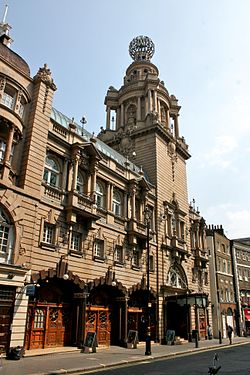
Cinerama is a widescreen process that originally projected images simultaneously from three synchronized 35mm projectors onto a huge, deeply curved screen, subtending 146-degrees of arc. The trademarked process was marketed by the Cinerama corporation. It was the first of several novel processes introduced during the 1950s when the movie industry was reacting to competition from television. Cinerama was presented to the public as a theatrical event, with reserved seating and printed programs, and audience members often dressed in their best attire for the evening.
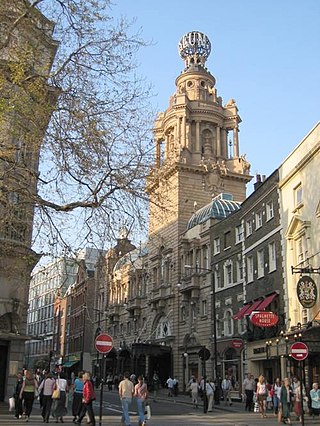
English National Opera (ENO) is a British opera company based in London, resident at the London Coliseum in St Martin's Lane. It is one of the two principal opera companies in London, along with The Royal Opera. ENO's productions are sung in English.

The Empire, Leicester Square is a cinema currently operated by Cineworld on the north side of Leicester Square, London, United Kingdom.

Sadler's Wells Theatre is a London performing arts venue, located in Rosebery Avenue, Islington. The present-day theatre is the sixth on the site. Sadler's Wells grew out of a late 17th-century pleasure garden and was opened as a theatre building in the 1680s.

The Cinerama Dome is a movie theater located at 6360 Sunset Boulevard in Hollywood, California. Designed to exhibit widescreen Cinerama films, it opened November 7, 1963. The original developer was William R. Forman, founder of Pacific Theatres. The Cinerama Dome continued as a leading first-run theater, most recently as part of the ArcLight Hollywood complex, until it closed temporarily in March 2020 due to the COVID-19 pandemic in California. The ArcLight chain closed permanently in April 2021, with the theater never having reopened. In June 2022, it was announced that there were plans to reopen it and the former ArcLight Hollywood under a new name, Cinerama Hollywood.

The Hippodrome is a building on the corner of Cranbourn Street and Charing Cross Road in the City of Westminster, London. The name was used for many different theatres and music halls, of which the London Hippodrome is one of only a few survivors. Hippodrome is an archaic word referring to places that host horse races and other forms of equestrian entertainment.
A roadshow theatrical release or reserved seat engagement is the practice of opening a film in a limited number of theaters in major cities for a specific period of time before the wide release of the film. Roadshows would generally mimic a live theatre production, with an upscale atmosphere as well as somewhat higher prices than during a wide release. They were commonly used to promote major films from the 1920s–60s and build excitement.

The Prince Edward Theatre is a West End theatre situated on Old Compton Street, just north of Leicester Square, in the City of Westminster, London.

Buxton Opera House is in The Square, Buxton, Derbyshire, England. It is a 902-seat opera house that hosts the annual Buxton Festival and the International Gilbert and Sullivan Festival, among others, as well as pantomime at Christmas, musicals and other entertainments year-round. Hosting live performances until 1927, the theatre then was used mostly as a cinema until 1976. In 1979, it was refurbished and reopened as a venue for live performance.

Francis Matcham was an English architect who specialised in the design of theatres and music halls. He worked extensively in London, predominantly under Moss Empires for whom he designed the Hippodrome in 1900, Hackney Empire (1901), Coliseum (1903) and Palladium (1910). His last major commission before retirement was the Victoria Palace (1911) for the variety magnate Alfred Butt. During his 40-year career, Matcham was responsible for the design and construction of over 90 theatres and the redesign and refurbishment of a further 80 throughout the United Kingdom.

The Bristol Hippodrome is a theatre located in The Centre, Bristol, England, United Kingdom with seating on three levels giving a capacity of 1,951. It frequently features shows from London's West End when they tour the UK, as well as regular visits by Welsh National Opera and an annual pantomime.

The Seattle Cinerama Theatre is a landmark movie theater in the Belltown neighborhood of Seattle, Washington, United States. The theater opened in 1963 and was renovated in the 1990s after its acquisition by Paul Allen. The Cinerama was closed in May 2020. At the time of its 2020 closure, it was one of only three movie theaters in the world capable of showing three-panel Cinerama films. In 2023, the theater was purchased by the Seattle International Film Festival (SIFF) and reopened on December 14, 2023 as SIFF Cinema Downtown due to trademark issues with the "Cinerama" name.
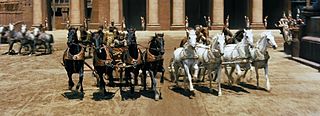
Ultra Panavision 70 and MGM Camera 65 were, from 1957 to 1966, the marketing brands that identified motion pictures photographed with Panavision's anamorphic movie camera lenses on 65 mm film. Ultra Panavision 70 and MGM Camera 65 were shot at 24 frames per second (fps) using anamorphic camera lenses. Ultra Panavision 70 and MGM Camera 65's anamorphic lenses compressed the image 1.25 times, yielding an extremely wide aspect ratio of 2.76:1.
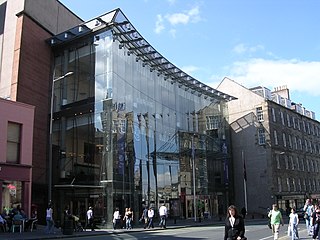
The Edinburgh Festival Theatre is a performing arts venue located on Nicolson Street in Edinburgh, Scotland. It is used primarily for performances of opera and ballet, large-scale musical events, and touring groups. After its most recent renovation in 1994, it seats 1,915. It is one of the major venues of the annual summer Edinburgh International Festival and is the Edinburgh venue for the Scottish Opera and the Scottish Ballet.

The Peacock Theatre is a West End theatre in the City of Westminster, located in Portugal Street, near Aldwych. The 999-seat house is owned by, and comprises part of the London School of Economics and Political Science campus, who use the theatre for lectures, public talks, conferences, political speeches and open days.
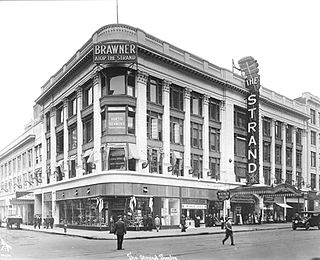
The Strand Theatre was an early movie palace located at 1579 Broadway, at the northwest corner of 47th Street and Broadway in Times Square, New York City. Opened in 1914, the theater was later known as the Mark Strand Theatre, the Warner Theatre, and the Cinerama Theatre. It closed as the RKO Warner Twin Theatre, and was demolished in 1987.
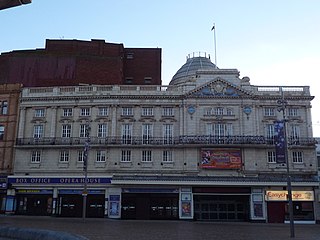
The Opera House Theatre is a theatre in Blackpool, Lancashire, England. It is located within the Winter Gardens, a large entertainment complex in the town centre and originally opened in 1889, although it has been rebuilt twice, in 1910 and 1939.

Everyman Theatre is a theatre based in Regent Street, Cheltenham. There are two auditoria in the building - the 718 seat main auditorium and the 60 seat Studio Theatre, originally named The Ralph Richardson Studio after Ralph Richardson.

The Loew's State Theatre was a movie theater at 1540 Broadway on Times Square in New York City. Designed by Thomas Lamb in the Adam style, it opened on August 29, 1921, as part of a 16-story office building for the Loew's Theatres company, with a seating capacity of 3,200 and featuring both vaudeville and films. It was the first theater on Broadway to cost $1 million. It was initially managed by Joseph Vogel, who later became president of Loew's Inc. and then MGM.
